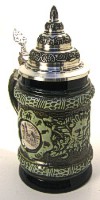Does the German Beer Stein mark have any special meaning
Does the German Beer Stein mark have any special meaning
 Does the German Beer Stein mark have any special meaning is dependent on how you interpret them. The one that leave the most ambiguous meaning are the lithophanes that are created in the bottom of the authentic German beer steins.
Does the German Beer Stein mark have any special meaning is dependent on how you interpret them. The one that leave the most ambiguous meaning are the lithophanes that are created in the bottom of the authentic German beer steins.
These lithophanes are all hand painted by the artesian that is given the task to create that particular stein at the shop where they are employed. Most, but not all of them are of angles whose meanings is only known by the artesian that has created them.
Many believe these are the healingly spirits that watch over the human race and protect them from evil. This included the original reason the German beer steins were created, which was to ward off the Black Death.
There was also a law passed in 1981 that required all imported products have their country of origin printed on the product. This was passed by the United States. Because of this many manufactures started placing not only the marking of "made in Germany" but also "Gemacht in Deutschland" was used. The main reason the English version was printed on so many German beer steins was so there was no ambiguity when being imported to the US.
 After that point in time many German beer stein manufactures also decided to patent their designs and mark their steins with special markings. The Mettlach inlays are well known and are easy to decipher since they used only one letter. The A describes the Juristen or Lawyer design which had an image of a scale hanging from a sword. B was Mediziner or doctor that had the 2 serpents wrapped around a staff. C was for the Phililogen or scholar that had two owls with one holding a fools hat.
After that point in time many German beer stein manufactures also decided to patent their designs and mark their steins with special markings. The Mettlach inlays are well known and are easy to decipher since they used only one letter. The A describes the Juristen or Lawyer design which had an image of a scale hanging from a sword. B was Mediziner or doctor that had the 2 serpents wrapped around a staff. C was for the Phililogen or scholar that had two owls with one holding a fools hat.
D was the mark of the Mathematiker or mathematician which was represented by a sphere with a compass on the stein. E was for the Naturforscher or natural scientist that had the design of a heart surrounded by numerous banners. F was used for the Architeken or architect that had the presence of a plum bob, T-square and compass. The G was for Ingenieure or engineer that had a cog or a gear. The H was used to describe the Forstleute or forester which had an oak tree growing out of a heart. The I was the Theologen or evangelical which was represented by the Wartburg Castle.
The K was Kaufleute or banker that had two snakes around a wiggled staff lying up against a book; this was different than the one made for the doctor. L represented the Bergleute or miner that had 2 hammers crossing at the handles. The R was not given a reference but is suspected to designate a special order.
 It was inlays like this along with other special marking that could include the artesian name, the town where the German beer stein was created or even the manufacturing company’s name. The only consistency was after the 1891 law that required the country of origin be placed on the stein. This way the markings can help tell the story along with the age of the stein for those looking into one’s history.
It was inlays like this along with other special marking that could include the artesian name, the town where the German beer stein was created or even the manufacturing company’s name. The only consistency was after the 1891 law that required the country of origin be placed on the stein. This way the markings can help tell the story along with the age of the stein for those looking into one’s history.
So the answer to the question "does the German Beer Stein mark have any special meaning" is yes.
